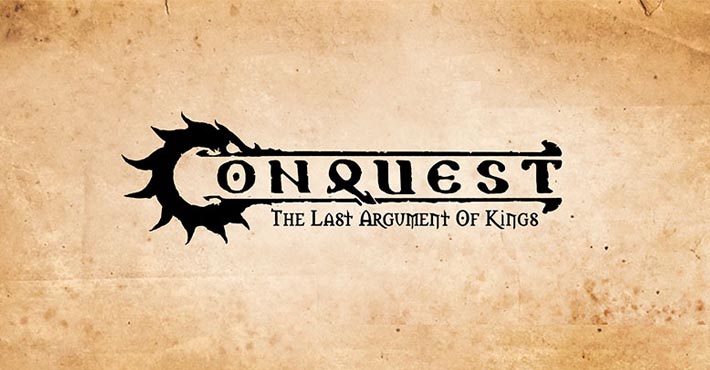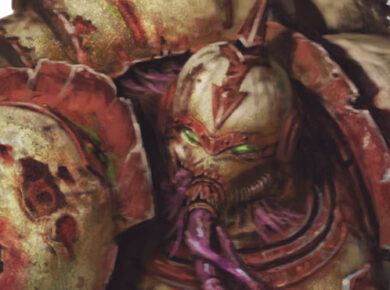Hello everyone,
We’re beginning our review of Chapter 2 of the Conquest rulebook. This chapter highlights the game structure of Conquest, divided into several strategic phases that offer both depth and tactical flexibility. Our analysis will focus on each of these distinct phases of the game. Before diving into this article, we strongly recommend reading our review of Chapter 1 first.
A Five-Phase Game Structure
Each game turn is divided into five distinct phases, each played alternately by both players :
- Reinforcements Phase : Undeployed regiments gradually enter the battlefield, based on a dice roll system that changes depending on the turn.
- Command Phase : Players secretly arrange their command cards, determining the activation order of their regiments for the upcoming turn.
- Supremacy Phase : A dice roll determines which player activates their supremacy abilities first, thereby influencing the pace of the turn.
- Action Phase : Players alternately activate their regiments or characters, following the order set during the Command Phase. Each activation allows for two distinct actions, offering a high degree of tactical flexibility.
- Victory Phase : At the end of the turn, the scenario’s victory conditions are checked. If any of them are met, the game ends. Otherwise, a new turn begins.
The Command Stack System: A Touch of Psychology
The Command Stack system is one of Conquest’s most innovative features. Each player secretly arranges the activation order of their regiments, adding an extra layer of strategic depth. This mechanism reduces cognitive load by removing the need to decide in real-time which unit to activate, while also allowing players to manipulate the activation order to surprise their opponent.
Action Phase : A Key Moment in the Game
Each active Regiment or Character has an Action Phase during which it can perform up to two actions from a wide variety of options. However, if for any reason a Regiment or Character cannot act, the player simply skips its Action Phase, treating it as activated without performing any actions. This straightforward rule ensures smooth gameplay while maintaining a clear tactical framework.
Out-of-Combat Actions vs. In-Combat Actions
The system clearly separates out-of-combat actions from close-combat actions, structuring decision-making based on the situation on the battlefield.
- Out-of-Combat Actions : These primarily include movement and preparation actions such as Marche (the only action that can be repeated), Charge, Rally (to restore the morale of broken Regiments), Reform (to change formation or orientation), Aim (to improve the next shot), and Volley Fire. These actions allow players to position their troops, prepare attacks, or recover struggling units.
- In-Combat Actions: When Regiments are in direct contact with enemy units, tactical options expand to include Strike (Clash), Rally in Combat, Reform in Combat (a tactical reorganization specific to melee), Inspire (a boost for attacks), Retreat (to disengage), and Pass.
As you can see, Conquest offers a multitude of strategic actions, each with the potential to turn the tide of a turn. Some are obvious and intuitive, while others leave room for doubt, especially when an optimal strategy suggests performing three actions to maximize a unit’s impact.
Free, Additional, and Out-of-Sequence Actions
Another strength of Conquest lies in its use of “free” and “additional” actions, granted by certain special effects or events. Free actions allow a unit to perform an action without spending one of its usual two actions, but they do not allow the same action to be repeated twice in a single turn. Additional actions, on the other hand, enable a unit to perform more of a specific action type, using a regular action slot. This mechanic adds significant tactical depth while maintaining a strict limit : no more than three actions can be performed per activation, preventing any form of excessive play.
Out-of-sequence actions, often triggered by events or special rules, occur outside of the standard activation flow. They allow for surprises and dynamic reactions, without counting toward the regular action limit. A free Reform action, for example, provides a real strategic advantage, it can get you out of tricky situations like a flank attack, while still preserving your unit’s offensive potential.
Victory Phase: The Outcome of the Battle
Once the Action Phase has been completed for both players, the Victory Phase begins to determine whether one side has won the game, either through opponent surrender or total annihilation. If not, the specific victory conditions of the scenario must be checked (such as victory point calculations). The game then continues with a new turn, starting again from the Reinforcements Phase, until a winner is declared or the game reaches its end.
That concludes our look at Chapter 2.
The summary above highlights a remarkably well-designed Action Phase, where the wealth of tactical options allows players to adapt their strategy as the battle unfolds. The strict limitation on the number of actions, combined with the mechanics of free and additional actions, creates a smart balance between tactical freedom and control over the game’s pacing.
This is precisely what makes each game immersive and, more importantly, highly replayable, even without changing your army list. The ever-evolving action dynamics ensure that no two battles feel the same. And when you factor in the ability to add or remove specific units, that sense of freshness is only further enhanced.
Without getting lost in a mess of overly complex rules, the action system remains easy to grasp, proving that Conquest is a relatively accessible game, even for newcomers. As a personal example, after reading the rules just once and playing a single test game, I jumped straight into a 16 players tournament. I finished 12th, going up against two top-3 veterans who knew their armies. A clear sign that Conquest is truly approachable, and that you can dive into competitive play quickly and confidently.
Stay tuned for Chapter 3, where we’ll dive into out-of-combat actions.
Don’t missed to support us on PATREON!
At the bottom of each post, you’ll find a list of all related blog entries, which we’ll update as the project evolves.
- Reviews : Conquest The Last Argument of Kings Chapter 1
- Reviews : Conquest The Last Argument of Kings Chapter 2
- Reviews : Conquest The Last Argument of Kings Chapter 3
- Reviews : Conquest The Last Argument of Kings Chapter 4
- Reviews : Conquest The Last Argument of Kings Chapter 5
- Reviews : Conquest The Last Argument of Kings Chapter 6
- Reviews : Conquest The Last Argument of Kings Chapter 7
- Reviews : Conquest The Last Argument of Kings Chapter 8
- Reviews : Conquest The Last Argument of Kings Chapter 9
- Reviews : Conquest The Last Argument of Kings Chapter 10
- Reviews : Conquest The Last Argument of Kings Chapter 11
- Reviews : Conquest The Last Argument of Kings Chapter 12
Questions, ideas, spelling error or just want to share your thoughts? Leave a comment below! And if you enjoy our work, a little support would help us keep creating more and more content.
See you soon!





